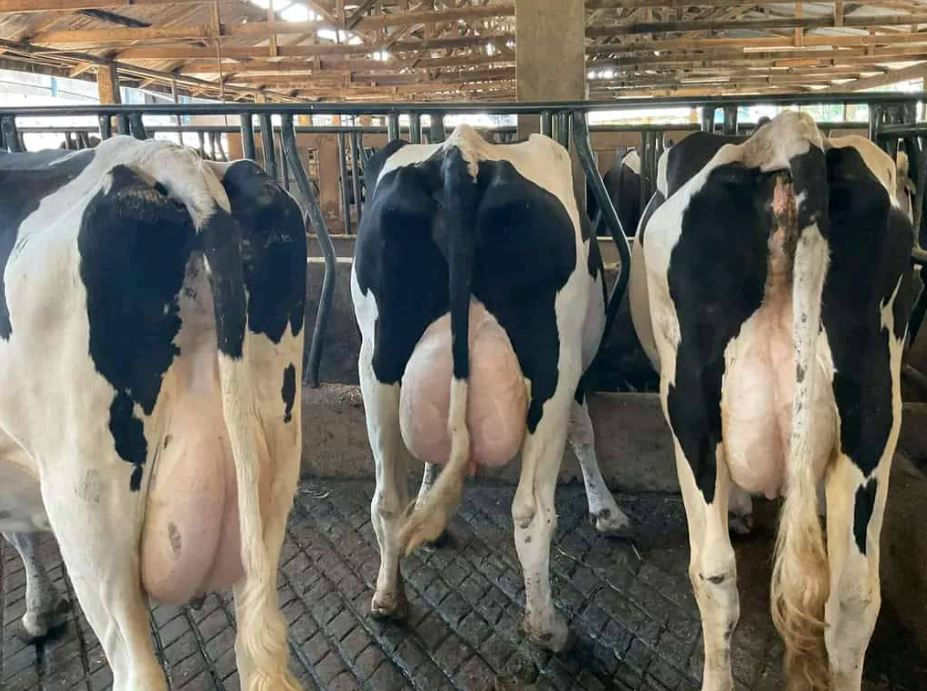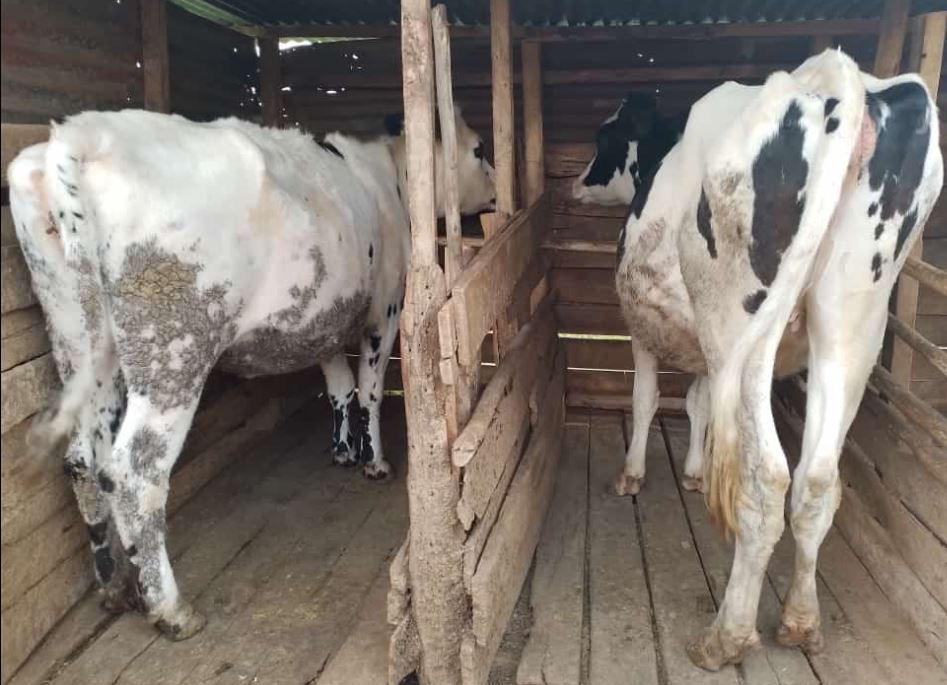Friesian Cow in Kenya (2025 Guide): Prices, Milk Production, Characteristics & Where to Buy
- BeyondForest

- 2 days ago
- 6 min read

Image of Two Holstein Friesians 4 months & 3 In calf heifers for sale
1.)What Is a Friesian Cow
2.)Friesian Cow Characteristics
4.)Friesian Cow Prices in Kenya (2025 Update)
5.)Friesian Heifers vs Mature Friesian Cows
7.)Friesian Calf Prices in Kenya
8.)Feeding Requirements for Friesian Cows
10.)Common Health Issues in Friesian Cows
Holstein → Originated in North Germany (Holstein region).
Friesian → Originated in The Netherlands (Friesland region).
Steaming up means increasing the cow’s nutrition and energy intake during the last trimester of pregnancy.
You give the cow better feed, more protein, more energy, and mineral supplements so that:
the calf grows properly
the cow prepares for high milk production
the body builds up energy for calving
the udder develops fully
the cow avoids diseases after calving
A Friesian cow, also known as the Holstein–Friesian, is a high-performance dairy breed originally from the Netherlands and Germany, globally recognized for its exceptional milk production. It is easily identified by its black-and-white coat patterns, large body size, and calm temperament.
Friesians can drink up to 150 litres of water a day.

Image of Pure Fresian Cows at a Farm In Githunguri Bubi Dairies
Friesians are engineered through decades of selective breeding to produce the highest milk yields among all dairy breeds, often exceeding 25–35 liters per day under good management. They mature early, have strong udder attachment, and adapt well to Kenya’s zero-grazing systems.
Five Freedoms of a Dairy Cow:
1. Freedom from hunger and thirst: Provide fresh water and feed 24/7.
2. Freedom from discomfort: Provide shelter with a dry, restful area and appropriate temperatures.
3. Freedom from pain, injury, and disease.
4. Freedom from fear.
5. Freedom to express normal patterns of behaviour e.g mounting.
Friesian Cow Characteristics
90% of the world’s commercial dairy milk comes from Holstein–Friesians.
Friesian cows are large-framed dairy animals known for their distinctive black-and-white coat, long body, and strong udder structure designed for high milk flow. They are highly fertile, mature early, and have short calving intervals, making them efficient for continuous milk production.
A Friesian’s spots are as unique as human fingerprints.
Friesians typically weigh 550–650 kg, with bulls reaching up to 900 kg. They have a calm, manageable temperament, excellent feed-to-milk conversion, and adapt well to zero-grazing or semi-intensive systems. Their hooves and legs are strong, supporting long hours of standing during milking and feeding.
Key Differences of Holstein and Friesian Cows
Feature | Holstein | Friesian |
Milk Volume | (30–40+ litres/day) | (25–35 litres/day) |
Body Size | Slightly bigger | Slightly smaller |
Origin | Germany | Netherlands |
Fertility | Average | Better |
A dry cow is a cow that is not being milked for about 60 days before calving.
This resting period helps her:
repair udder tissue
rebuild body condition
prepare for the next lactation
Drying off is VERY important.
Friesian milk production in Kenya increases with each calving, reaching peak yield in mid-lactation. During the first calving, most Friesians produce 20–25 litres per day as their udder and body are still developing.
Image of two Holstein Fresian Cows at a Farm In Githunguri
At the second calving, yield rises to 30–35 liters under proper feeding and mineral supplementation. Milk output remains strong during the third calving, averaging 30–40 liters per day, which is usually the cow’s production peak. By the fourth calving onward, the graph gradually declines due to age-related udder stress, reduced fertility, and slower metabolism, though good management can still maintain respectable yields.
Most Friesians peak in milk production at 2nd–3rd lactation.
Friesian Cow Prices in Kenya (2025 Update)
Cow Type | Age | Milk Production | Condition | Price |
Pure Friesian in-milk cow | 3.5 years | 28–32 L/day | Freshly calved | 160,000Ksh |
Friesian heifer (7 months pregnant) | 2.8 years | In-calf | 145,000Ksh | |
Grade Friesian dairy cow | 4 years | 22–25 L/day | Freshly calved | 130,000Ksh |
Holstein Friesian high-yield cow | 5 years | 30–35 L/day | In-milk | 175,000Ksh |
Friesian heifer (5 months pregnant) | 2.5 years | In-calf | 125,000Ksh | |
Friesian cow (2 weeks fresh) | 4.2 years | 26–29 L/day | Freshly calved | 155,000 |
Pure Friesian heifer (AI bred) | 2.3 years | In-calf | 135,000 | |
Friesian × Ayrshire cross | 3.8 years | 20–23 L/day | In-milk | 115,000 |
Friesian cow (high pedigree) | 5.5 years | 32–36 L/day | Freshly calved | 180,000 |
Friesian Heifers vs Mature Friesian Cows

Friesian heifers and mature Friesian cows differ significantly in productivity, body development, and management needs. Heifers are young females that have not calved or have just calved once, meaning their milk production is still developing and typically ranges between 20–25 liters during the first lactation. They have smaller body frames, lighter weight, and require careful nutrition to support both growth and pregnancy. Mature Friesian cows, especially from the second to third lactation, are fully developed and produce 30–40 liters per day, showing better udder capacity, stronger fertility cycles, and higher feed conversion efficiency. Their maintenance cost increases slightly with age, but milk output is significantly higher.
Friesian Bull Weight & Growth Rate
Friesian bulls are among the fastest-growing dairy breeds, developing strong muscle mass and large body frames. At birth, they weigh 35–45 kg, reaching 150–180 kg by six months with proper feeding. By one year, a Friesian bull can weigh 250–320 kg, and mature bulls commonly reach 700–900 kg, with some exceeding 1,000 kg under intensive feeding. Their growth rate demands high-protein diets, minerals, and adequate space to support bone strength and prevent early joint stress.
Calf Type | Age | Gender | Price |
Pure Friesian heifer calf | 4 months | Female | 38,000 |
Friesian bull calf | 6 months | Male | 45,000 |
Grade Friesian heifer calf | 5 months | Female | 32,000 |
Holstein Friesian heifer | 3 months | Female | 42,000 |
Friesian cross calf | 5 months | Male | 28,000 |
Friesian heifer calf (AI bred) | 7 months | Female | 50,000 |
Friesian bull calf | 4 months | Male | 35,000 |
Friesian × Ayrshire heifer calf | 6 months | Female | 30,000 |
Pure Friesian bull calf | 3 months | Male | 40,000 |
Friesian heifer calf | 7 months | Female | 52,000 |
Feeding Requirements for Friesian Cows

High-Quality Forage: Napier grass, maize silage, Rhodes hay, and fresh pasture as the main energy source.
Dairy Meal Supplementation: 2–4 kg per milking depending on milk yield (0.5–1 kg dairy meal per 2 liters of milk).
Protein-Rich Feeds: Lucerne, calliandra, desmodium, soya meal, and cottonseed cake for milk production.
Minerals & Vitamins: Daily mineral lick, calcium, phosphorus, and salt to support udder health and fertility.
Clean Water: 60–100 liters of water per cow per day.
Consistent Feeding Schedule: Regular feeding intervals to maintain rumen health and stable milk yield.
Best Friesian Cow Farms & Breeders in Kenya
ADC Kitale | Kitale (Rift Valley) |
Tassells Farm Limited | Githunguri, Ruiru, Naivasha & Kitui |
Bubi Dairies | Githunguri |
Delamere Farm Naivasha | Naivasha region |
Common Health Issues in Friesian Cows
many farmers wrongly keep milking a cow up to calving, or the cow dries up by itself too late.
This is BAD because:
calf may be born weak
cow may become weak
milk production after calving becomes low
cow may get ketosis and milk fever, two dangerous diseases
Mastitis: The most common problem in high-yielding Friesians, caused by bacteria entering the udder. Leads to reduced milk quality and swelling.
Milk Fever (Hypocalcemia): Occurs around calving due to low calcium levels, causing weakness and inability to stand.
Want To Learn More About Cow Diseases and Symptoms Click Here >>>
Ketosis: Caused by energy deficiency after calving, leading to reduced appetite and milk drop.
Foot & Hoof Problems: Overgrown hooves, foot rot, and lameness due to constant standing in zero-grazing units.
Bloat: Often from sudden diet changes or lush pasture intake.
Parasites: Worms, ticks, and flukes reduce milk production and overall health.
Reproductive Challenges: Retained placenta, difficult calving, or irregular heat cycles.
Respiratory Diseases: Pneumonia in calves and adults due to cold, dust, or overcrowded housing.
Frequently Asked Questions About Friesian
How much milk does a Friesian cow produce per day in Kenya?
A Friesian cow produces 20–25 liters on first calving, 30–35 liters on second, and 30–40 liters on third calving. After the 4th calving, production gradually declines.
How much does a Friesian cow cost in Kenya?
Prices range from 130,000Ksh–280,000Ksh depending on milk yield, age, genetics, and calving status. High-yield pure Friesians cost more.
How much is a Friesian calf in Kenya?
Friesian calves cost 28,000Ksh–55,000Ksh, with heifer calves being more expensive than bull calves.
What is the difference between a Friesian and Holstein cow?
Historically they were separate breeds, but today they are combined into one global breed called Holstein–Friesian. Farmers simply call them “Friesians.”
High-quality forage (Napier, hay, silage), dairy meal (2–4 kg per milking), mineral supplements, protein feeds (lucerne, desmodium) and 60–100 liters of water daily.
What are the common health issues in Friesian cows?
Mastitis, milk fever, ketosis, foot problems, parasites, bloat, pneumonia, and reproductive challenges like retained placenta.
At what age does a Friesian heifer start producing milk?
Most Friesian heifers calve for the first time at 24–30 months, after which they begin producing milk.
How long is the gestation period of a Friesian cow?
Approximately 9 months (280 days).
They have high milk output, good feed conversion, strong genetics, early maturity, and adapt well to zero-grazing systems.
Where can I buy Friesian cows in Kenya?
Reliable sources include Githunguri, Kitale ADC, private dairy farms, and online platforms like Jiji and verified breeders listed on BeyondForest.









Comments